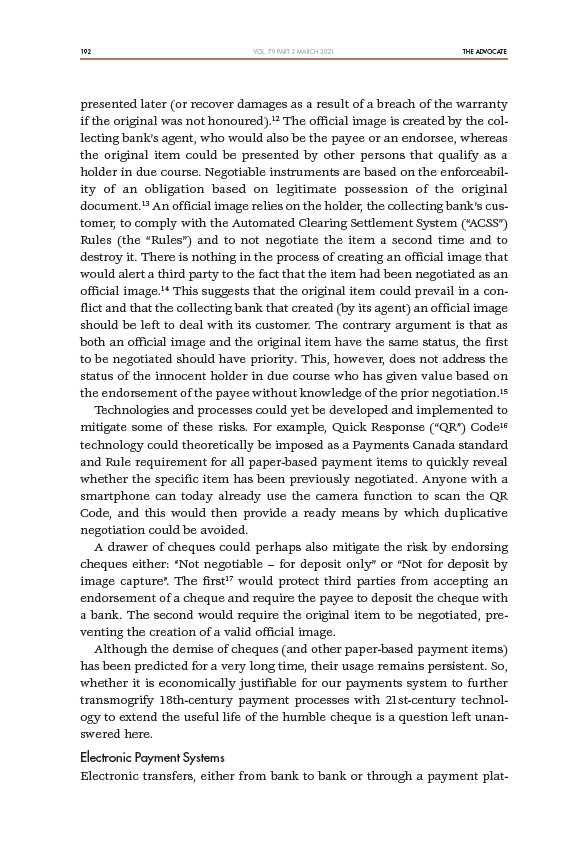
192 THE ADVOCATE
VOL. 79 PART 2 MARCH 2021
presented later (or recover damages as a result of a breach of the warranty
if the original was not honoured).12 The official image is created by the collecting
bank’s agent, who would also be the payee or an endorsee, whereas
the original item could be presented by other persons that qualify as a
holder in due course. Negotiable instruments are based on the enforceability
of an obligation based on legitimate possession of the original
document.13 An official image relies on the holder, the collecting bank’s customer,
to comply with the Automated Clearing Settlement System (“ACSS”)
Rules (the “Rules”) and to not negotiate the item a second time and to
destroy it. There is nothing in the process of creating an official image that
would alert a third party to the fact that the item had been negotiated as an
official image.14 This suggests that the original item could prevail in a conflict
and that the collecting bank that created (by its agent) an official image
should be left to deal with its customer. The contrary argument is that as
both an official image and the original item have the same status, the first
to be negotiated should have priority. This, however, does not address the
status of the innocent holder in due course who has given value based on
the endorsement of the payee without knowledge of the prior negotiation.15
Technologies and processes could yet be developed and implemented to
mitigate some of these risks. For example, Quick Response (“QR”) Code16
technology could theoretically be imposed as a Payments Canada standard
and Rule requirement for all paper-based payment items to quickly reveal
whether the specific item has been previously negotiated. Anyone with a
smartphone can today already use the camera function to scan the QR
Code, and this would then provide a ready means by which duplicative
negotiation could be avoided.
A drawer of cheques could perhaps also mitigate the risk by endorsing
cheques either: “Not negotiable – for deposit only” or “Not for deposit by
image capture”. The first17 would protect third parties from accepting an
endorsement of a cheque and require the payee to deposit the cheque with
a bank. The second would require the original item to be negotiated, preventing
the creation of a valid official image.
Although the demise of cheques (and other paper-based payment items)
has been predicted for a very long time, their usage remains persistent. So,
whether it is economically justifiable for our payments system to further
transmogrify 18th-century payment processes with 21st-century technology
to extend the useful life of the humble cheque is a question left unanswered
here.
Electronic Payment Systems
Electronic transfers, either from bank to bank or through a payment plat-